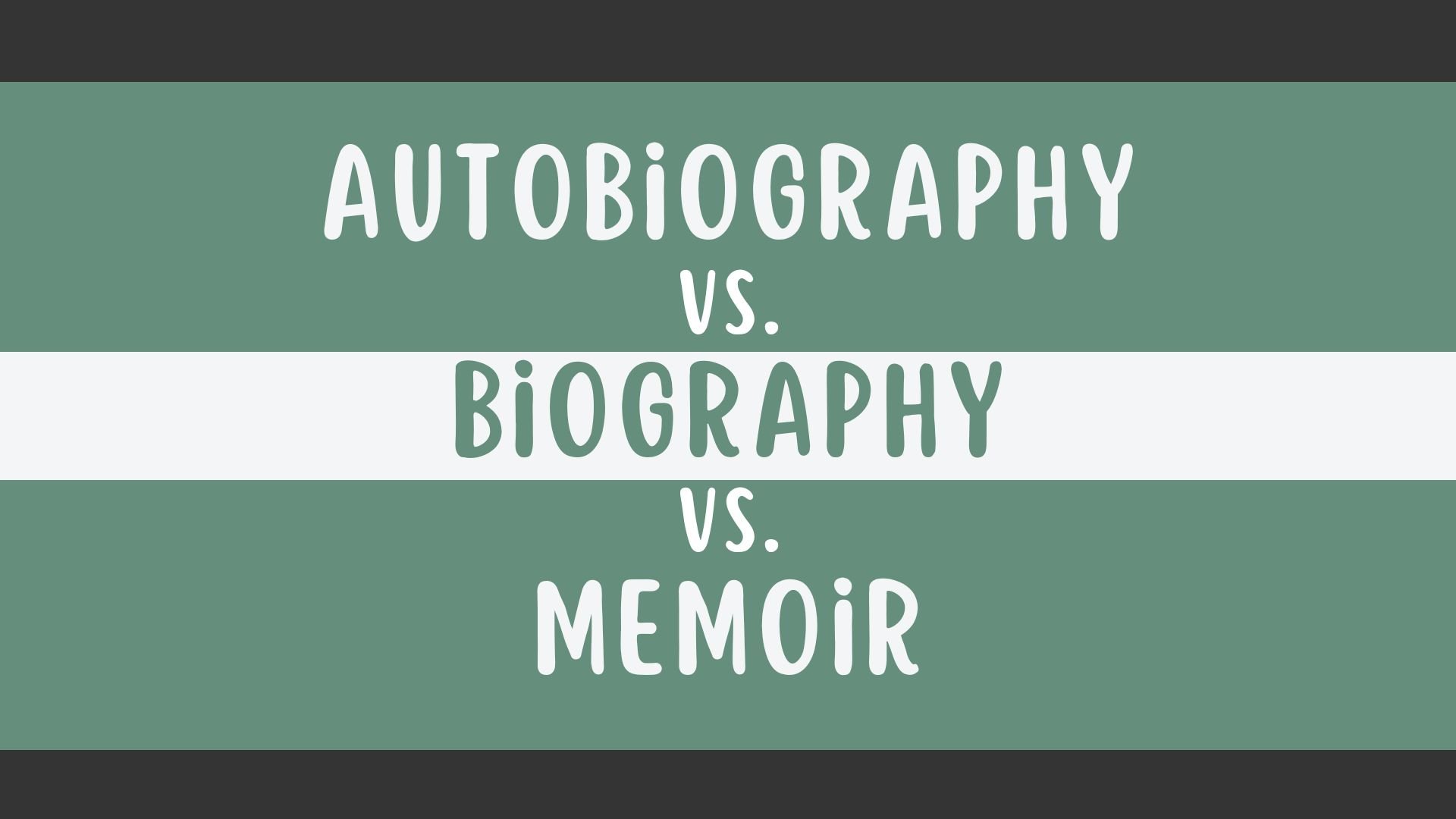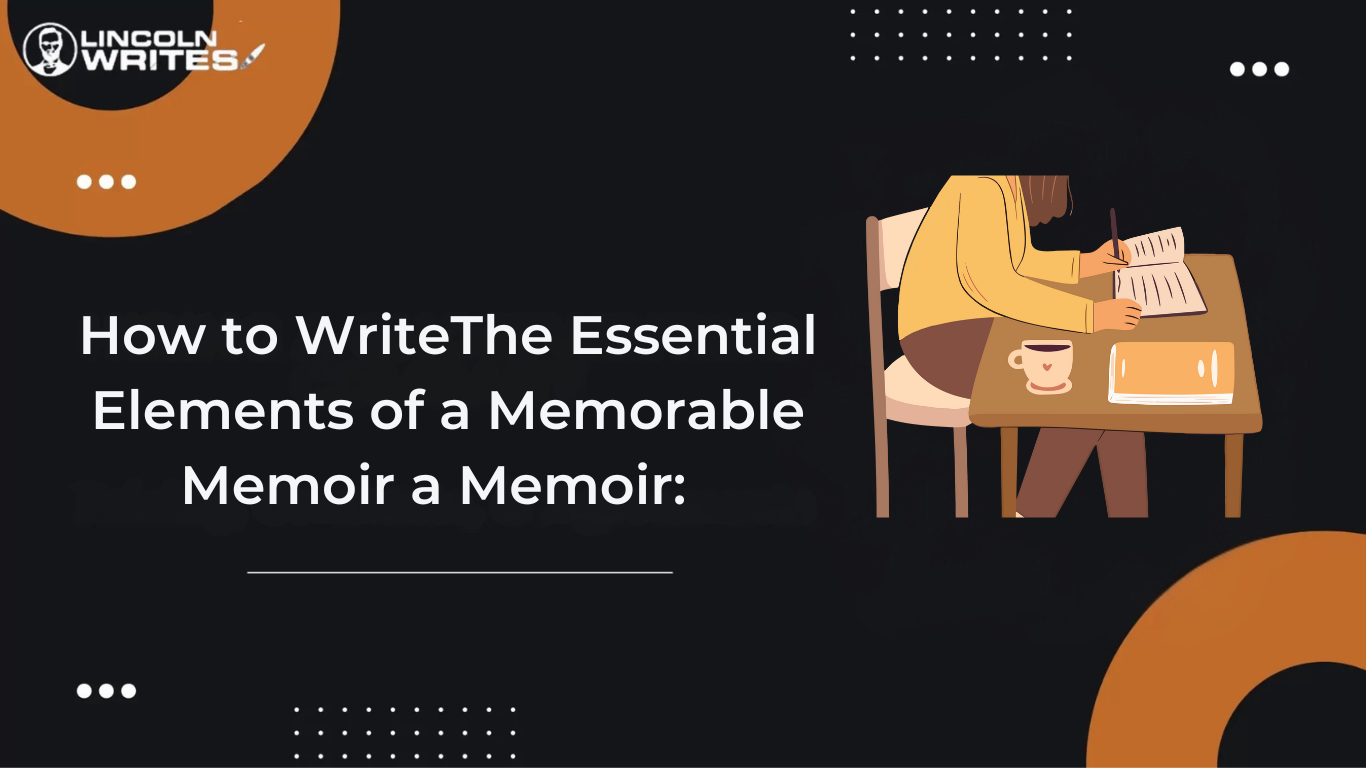Remember, everyone who has lived and is living has a complete story of how they got there. Some are of life’s tragedies and how they’re still moving with a glimmer of hope, while others are tales of resilience and getting back up after every biggest life’s beat down. If you’re reading this you have one too.
If you thought of putting pen to paper (or fingers to keyboard), then consider writing a memoir. But how can you make one that’s worth remembering? Well, it’s more than just a diary entry with a fancy cover. There are some elements of a memoir that make it so that people remember it. This guide will delve into those key elements that make them truly captivating. Additionally, it will cover some practical flaws to avoid and what to do after you’re done writing one. So, if you want to immortalize your story till the end of times, give this 10-minute guide a quick read.
Elements of a Memoir that Make it Memorable

If you’ve ever thought about writing a memoir, chances are you’ve asked yourself, “What exactly makes a memoir tick?” Spoiler alert: It’s not just a diary dressed in fancy words. A good memoir has layers—kind of like an onion, but way less likely to make you cry while peeling it back (although some do). Let’s dive into the key elements that make up a memoir worth remembering.
1. Personal Narrative
Your memoir starts with you. That’s right—your story, your voice, and your experiences take center stage. But here’s the kicker: It’s not about fitting every single thing that’s ever happened to you into 300 pages. Instead, focus on a compelling thread that ties your story together. This is where personal narrative techniques come in handy—like vivid descriptions, emotional depth, and good ol’ honesty.
Use sensory details, dialogue, and pacing to breathe life into your story. Have you ever heard of Show, not Tell? That’s what you want in your memoir. For reference, consider this example: you’re writing about a summer road trip that changed your life. Instead of listing every pit stop and pothole you came across, hone in on the moment when you realized your dream. The magic lies in the details that transport readers into your shoes. The better you can make them fit in them, the more they can relate and connect with you.
2. Themes that Resonate
Another essential element of a memoir is the theme. A great memoir isn’t just about recounting events; it’s about meaning. Readers crave themes that connect with their own lives. That’s where themes in memoir writing come into play—identity, resilience, love, loss, or even rediscovery. Themes act like the glue that holds your memoir together.
Think about Cheryl Strayed’s Wild. It’s not just about hiking—it’s about healing, perseverance, and finding oneself. So, what’s your big idea? What’s the deeper takeaway you want your readers to walk away with?
3. Structure Matters
Let’s be real: a rambling story is about as fun as reading a 10,000-word email chain (we’re kidding here if you thought we were serious). That’s why the structure of a memoir is a big deal. Do you want to tell your story chronologically, or are you feeling bold enough to jump back and forth between timelines? Maybe you’ll use flashbacks to connect the dots.
Whatever structure you choose, make sure it’s easy for readers to follow. A messy timeline might work for Christopher Nolan movies, but your readers deserve clarity and flow. Only do it if you are confident in your writing ability; otherwise, a linear flow is nothing to be ashamed of.
4. Authenticity is Key
If there’s one thing readers can sniff out from a mile away, it’s inauthenticity. Your memoir should be as raw and real as your Facebook posts when you turned 13, but minus the cringe. Vulnerability is what hooks readers. They want to know your struggles, your triumphs, and everything in between.
5. Obstacles
Every story worth reading has its challenges, and the same goes for memoirs. Obstacles are another essential element of a memoir. They are the heartbeat of your narrative—the tension that keeps readers hooked. They’re not just the hurdles you face but also the moments that define your growth and resilience. By sharing your struggles, you invite readers to connect with your humanity and root for your triumphs.
Think about it: who doesn’t love a comeback story? Whether it’s navigating personal loss, overcoming self-doubt, or tackling life-altering events, these challenges add depth and relatability to your memoir. Your obstacles don’t have to be dramatic to be impactful—what matters is how you convey their significance in your journey.
Common Flaws of a Memoir that Can Cause People to Forget

While the above elements of a memoir do make them unforgettable, there are also a few practices that can do the complete opposite. If you want your memoir to leave a lasting impression, it’s crucial to avoid these common flaws that can turn your story into something readers forget faster than yesterday’s weather.
1. You Have Written a Story Focused on Pain or Victimhood—and Nothing More
Let’s get real: pain is part of life, and it often plays a starring role in memoirs. But if your story is solely about suffering without any growth, resolution, or takeaway, it’s like watching a sad movie without an ending—just draining and unfulfilling. Nobody wants a sudden, slow bur trauma dump. Readers crave hope, resilience, and lessons learned. By showing how you navigated through your struggles and emerged on the other side, you’ll inspire and engage your audience rather than leave them stuck cringing at your pain.
2. Your Source Material is a Diary or Journal
Journals and diaries are fantastic for capturing raw thoughts and emotions at the moment, but they’re not meant to be your final draft. If your memoir feels like a collection of diary entries strung together, it might lack the structure and polish that make a story cohesive. A diary provides the groundwork, but a memoir needs narrative direction, thematic depth, and, yes, a bit of editing magic. Readers need to feel like they’re on a purposeful journey, not through the diary of a high schooler going through puberty.
3. You Want to Tell About Your Experience as a Means of Self-Help for Others
Sharing your story to help others is noble, but there’s a fine line between inspiring readers and lecturing them. If your memoir reads like a self-help book disguised as a personal story, it might feel preachy or forced.
The best memoirs inspire through authenticity—not because the author explicitly tells readers what to do, but because they see themselves in the author’s journey. Focus on telling your story with honesty, and let the inspiration happen naturally.
4. You Have No Definitive Story Arc or Story Problem
Every good story needs a clear beginning, middle, and end. If your memoir doesn’t have a definitive story arc—a problem to solve or a journey to complete—it’s like a road trip with no destination. Readers might enjoy the scenery, but they’ll eventually wonder, “Where is this going?” A memoir without a clear arc risks feeling aimless and forgettable. Define your central conflict or question early on, and let it guide the flow of your narrative.
Is Memoir and Autobiographies the Same?

Most people often confuse a memoir with an autobiography due to how they’re focused on providing personal accounts of someone. However, they’re different. After learning about the essential elements of a memoir, it’s crucial that you know how they’re different from autobiographies. Understanding these major nuances can help you refine your storytelling approach and ensure your narrative hits the mark. Let’s learn about the differences first:
Differences Between Memoir and Autobiography
| Aspect | Memoir | Autobiography |
| Focus | A specific theme, event, or period in life | A comprehensive account of one’s life |
| Scope | Narrow and targeted | Broad, covering a lifetime |
| Tone | Personal and reflective | Historical and factual |
| Purpose | To share personal insights and emotions | To document life events and achievements |
| Audience | Emotional connection with readers | Historical or informational readers |
We have a completely separate guide to offer a more in-depth comparison between memoirs and autobiographies. So consider checking it out if you’re still not clear about the difference.
While memoirs center on a particular chapter of life, offering a window into its emotional landscape, autobiographies strive to present a chronological and detailed life history. Think of a memoir as a close-up photograph, while an autobiography is the entire photo album.
Similarities Between Memoir and Autobiography
Despite their differences, you can find some elements of memoirs in autobiographies as well:
- Both Are True Stories: Authenticity is at the heart of both genres. Readers expect genuine accounts, even if the focus differs.
- Personal Voice: Whether you’re writing about a single defining event or an entire life, your voice shapes the narrative.
- Storytelling Techniques: Both memoirs and autobiographies benefit from vivid descriptions, engaging pacing, and relatable themes.
Choosing the Right Approach
Ultimately, whether to write a memoir or an autobiography depends on the story you want to tell. If your goal is to explore a transformative experience or specific theme, a memoir is your best bet. But if you aim to document your entire life’s journey, an autobiography is the way to go.
Never Forget – Editing and Revising
Just knowing about the elements of a memoir and writing isn’t enough to make it professional. However, refining those words until they sparkle will help. This is where editing and revising step in.
Editing a memoir isn’t just about fixing typos (though, yeah, please do that too). It’s about making sure your story flows, your voice shines, and your readers stay hooked from start to finish. Here’s how to do it right:
Step 1 – Take a Breather
First things first: step away from your manuscript. Seriously. Give it a week or two to marinate. When you come back with fresh eyes, you’ll catch issues you didn’t even notice before.
Step 2 – Focus on the Big Picture
Before you get into the nitty-gritty, look at the overall structure. Does your memoir have a clear arc? Are the themes consistent? Does the story build toward a satisfying resolution? Addressing these questions will help you tighten your narrative and avoid any “Wait, what’s happening?” moments for your readers.
Step 3 – Cut the Fluff
We know—it’s hard to let go of those beautifully written paragraphs. But if they don’t serve the story, they’ve got to go. Be ruthless. Every sentence should earn its place on the page.
Step 4 – Get Feedback
You need fresh perspectives. Share your draft with trusted readers (think critique groups or beta readers, not just your mom). Ask them what works, what doesn’t, and where they got bored.
Step 5 – Polish, Polish, Polish
Now, it’s time for the finer details. Fix clunky sentences, tighten dialogue, and watch for overused words. Make sure your tone is consistent, and your voice feels authentic. This is where your memoir goes from good to unforgettable.
Step 6 – Proofread Like a Pro
Finally, proofread. Then, proofread again. A single typo can yank readers out of your story faster than you can say “memoir.”
Step 7 – Hire an Editor to Carry Out All the Steps
Sometimes, you need a pro. Hiring an experienced editor can be the game-changer your memoir needs. Editors bring an objective perspective, catch mistakes you’ve overlooked, and help refine your narrative to its best possible version. They’ll ensure your story flows seamlessly, your tone remains consistent, and your themes shine through. Investing in professional editing is investing in your story’s impact.
Editing and revising might not be glamorous, but they’re where the magic happens. Your first draft is just the skeleton; this is where you add the muscle, the heart, and the soul. So don’t rush it. Take your time, and make every word count.
What to do After Writing – Publishing Route to Take?
If you’re reading this, that means you’ve done it. You’ve poured your soul into the pages, tackled the elements of a memoir, and polished your story until it shines. Now what? It’s time to decide how you want to share your masterpiece with the world. Choosing the right publishing route is as personal as writing your memoir itself, so let’s break it down.
Traditional Publishing
This is the dream route for many—getting your memoir picked up by a big-name publisher. Traditional publishing comes with perks like professional editing, wide distribution, and that sweet, sweet credibility of being “traditionally published.” But heads up: the journey isn’t easy. You’ll need a solid query letter, an agent, and a manuscript that stands out in a crowded market.
Pro tip: Focus on pitching to agents who specialize in memoirs. They’ll know exactly how to position your story to publishers. But if you can’t get that tough break, there’s always self-publishing.
Self-Publishing
Want full control over your memoir? Self-publishing might be your jam. With platforms like Amazon Kindle Direct Publishing, IngramSpark, and Lulu, you can take charge of every aspect—from design to marketing. The downside? You’re the one footing the bill and doing all the heavy lifting. But hey, the royalties are all yours.
Self-publishing is ideal if you have a clear vision for your book and don’t mind wearing multiple hats—writer, marketer, and entrepreneur.
Which Route is Right for You?
It all depends on your goals. If you’re chasing literary accolades and wide distribution, traditional publishing might be worth the grind. If you’re itching to get your story out there quickly and retain creative control, self-publishing is your go-to. No matter which path you take, remember this: your memoir’s value doesn’t depend on the publishing method. It’s the story—and how it connects with readers—that matters most.
Final Note
Writing a touching memoir is a deeply personal journey. By understanding the core elements of a memoir, you can craft a narrative that is not only compelling but also meaningful. Remember to embrace your authentic voice, explore the deeper themes that resonate with you, and don’t shy away from the challenges that have shaped your life. Regardless of your publishing choice, the most important thing is to share your story with the world.
FAQ – Frequently Asked Questions
Q1: What are the key differences between a memoir and an autobiography, and how does this impact the writing process?
A: Memoirs and autobiographies might sound similar to what they’re focused on, but both are completely different forms of writing. Here is how you can distinguish a memoir from an autobiography.
Memoir:
- Focuses on a specific theme, period, or event in life.
- More intimate and emotionally driven.
- Allows for greater freedom in terms of structure and chronology.
- Examples: “Eat, Pray, Love” by Elizabeth Gilbert and “Wild” by Cheryl Strayed.
Autobiography:
- Aims to provide a comprehensive and chronological account of a person’s life.
- Often emphasizes historical accuracy and factual details.
- It can be more objective and less emotionally charged.
- Examples: “The Autobiography of Malcolm X,” and “Becoming” by Michelle Obama.
Q2: Is it necessary to have a formal education in writing to write a compelling memoir?
A: Absolutely not! While formal training can be beneficial, it’s not a prerequisite for writing a successful memoir. Here’s why:
- Passion and Authenticity: The most crucial elements are a compelling story, genuine emotions, and a unique voice.
- Life Experience: Your personal experiences and insights are your greatest assets.
- Workshops and Resources: Numerous resources are available, such as writing workshops, online courses, and books on memoir writing, to help you hone your craft.
Q3: Can I use my journal entries as the basis for my memoir, or should I start from scratch?
A: Your journal entries can be a valuable resource, but they shouldn’t be treated as a direct draft for your memoir. Here’s why:
- Raw Material: Journals capture raw emotions and thoughts, which can be invaluable for uncovering deeper themes and memories.
- Refining the Narrative: Use your journal entries as a starting point to identify key events, emotions, and themes. Then, organize and refine them into a cohesive narrative with a clear beginning, middle, and end.
- Adding Context and Depth: Expand on journal entries by adding context, dialogue, and sensory details to create a richer and more engaging story.
Q4: What is the single most important element in making a memoir truly memorable?
A: While all the elements discussed (personal narrative, themes, structure, authenticity, obstacles) are crucial, authenticity arguably reigns supreme. Here’s why:
- Building Trust with Readers: Readers connect with stories that feel genuine and honest.
- Emotional Impact: Authenticity allows readers to connect deeply with their emotions and experiences.
- Inspiring Others: Sharing your authentic self can inspire others to embrace their own vulnerabilities and stories.
Q5: How can I find beta readers for my memoir, and what should I look for in a good beta reader?
A: Finding the right beta readers is crucial for receiving constructive feedback. Here are some tips:
- Writing Groups: Join local writing groups or online communities to connect with fellow writers.
- Workshops: Attend writing workshops where you can exchange feedback with other participants.
- Friends and family (with a caveat): Choose friends and family who are honest and critical readers but who also understand the sensitive nature of your work.
Look for beta readers who:
- Are active readers with diverse reading tastes?
- Are willing to provide constructive feedback.
- Can identify strengths and weaknesses in your writing.
- Understand the importance of maintaining confidentiality.
Q6: Should I hire a professional editor for my memoir, and if so, what are the benefits?
A: Hiring a professional editor is highly recommended, especially if you’re serious about publishing your memoir. Here are the benefits:
- Improving Clarity and Flow: Editors can help you identify and correct grammatical errors, awkward phrasing, and inconsistencies in style and tone.
- Enhancing Structure and Pacing: Editors can help you refine the overall structure of your memoir, ensuring a smooth and engaging reading experience.
- Polishing Your Voice: Editors can help you refine your unique voice and ensure it shines throughout the narrative.
- Catching Overlooked Issues: A fresh pair of eyes can catch errors and inconsistencies better that you might have missed.




